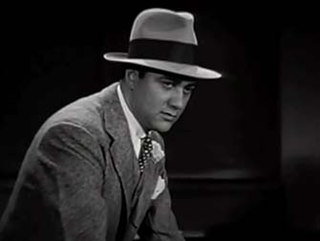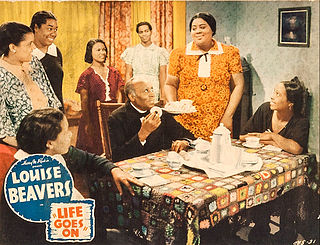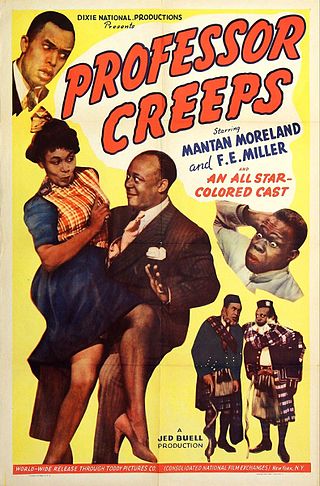
Million Dollar Productions was a movie studio in the United States active from 1937 until 1940. [1] It was established to produce films with African American casts. [2] It was a partnership between Harry M. Popkin, Leo C. Popkin and Ralph Cooper.

Million Dollar Productions was a movie studio in the United States active from 1937 until 1940. [1] It was established to produce films with African American casts. [2] It was a partnership between Harry M. Popkin, Leo C. Popkin and Ralph Cooper.
Ralph Cooper was an experienced black actor nicknamed "Dark Gable" [3] who was also a singer, dancer, comedian and emcee at the Apollo Theater Amateur Night in Harlem. While contracted to 20th Century Fox, Cooper learned film making skills. [4] Together with George Randol, he formed Cooper-Randol Productions to produce Dark Manhattan (1937). Using the experience he went into partnership with the Popkin brothers, Harry and Leo to form Million Dollar Productions. Harry Popkin owned and managed a chain of Circle Theatres in Los Angeles. One of these was the Million Dollar Theatre [5] that catered to a black clientele. [6]
The production company made several fast moving genre pictures with budgets, despite its name, of approximately $8,000 to $10,000 with the films shot in seven days. [7] Cooper not only starred but wrote and directed several films as well as bringing Lena Horne in to co-star with him. Cooper left the company in 1939, according to one source because he was tired of only making gangster films, with another source feeling he desired the financing and distribution control of the Popkin brothers. [8] In the same year Million Dollar Productions merged with Sack Amusement Enterprises, another film business specializing in race films. It offered better distribution opportunities. Other black stars appearing in Million Dollar Productions were Nina Mae McKinney, Mantan Moreland, Laurence Criner and Louise Beavers. Production ceased at the start of American involvement in World War II.
Following World War II, the Popkin brothers produced several well regarded mainstream Hollywood films such as D.O.A. (1950) and The Well (1951).
News photographer turned film maker Edward Lewis made documentary films such as Life in Harlem and the series' Colored America on Parade and The Colored Champions of Sport for the company. [9]

Lena Mary Calhoun Horne was an American singer, actress, dancer, and civil rights activist. Horne's career spanned more than seventy years, appearing in film, television, and theatre. Horne joined the chorus of the Cotton Club at the age of sixteen and became a nightclub performer before moving on to Hollywood and Broadway.

The Cotton Club was a New York City nightclub from 1923 to 1940. It was located on 142nd Street and Lenox Avenue (1923–1936), then briefly in the midtown Theater District (1936–1940). The club operated during the United States' era of Prohibition and Jim Crow era racial segregation. Black people initially could not patronize the Cotton Club, but the venue featured many of the most popular black entertainers of the era, including musicians Fletcher Henderson, Duke Ellington, Jimmie Lunceford, Chick Webb, Louis Armstrong, Count Basie, Fats Waller, Willie Bryant; vocalists Adelaide Hall, Ethel Waters, Cab Calloway, Bessie Smith, Lillie Delk Christian, Aida Ward, Avon Long, the Dandridge Sisters, the Will Vodery choir, The Mills Brothers, Nina Mae McKinney, Billie Holiday, Midge Williams, Lena Horne, and dancers such as Katherine Dunham, Bill Robinson, The Nicholas Brothers, Charles 'Honi' Coles, Leonard Reed, Stepin Fetchit, the Berry Brothers, The Four Step Brothers, Jeni Le Gon and Earl Snakehips Tucker.

The Duke Is Tops is a 1938 American musical film released by Million Dollar Productions and directed by William Nolte. The film was later released in 1944 under the title The Bronze Venus. It features top-billed Lena Horne in her film debut, along with Ralph Cooper. The film was one of the low-budget musical film "race movies" made in the 1930s and 1940s for the African-American market. The casts and production teams of these films were almost all black, and the music reflected current tastes in jazz and rhythm and blues.

The race film or race movie was a genre of film produced in the United States between about 1915 and the early 1950s, consisting of films produced for black audiences, and featuring black casts. Approximately five hundred race films were produced. Of these, fewer than one hundred remain. Because race films were produced outside the Hollywood studio system, they were largely forgotten by mainstream film historians until they resurfaced in the 1980s on the BET cable network. In their day, race films were very popular among African-American theatergoers. Their influence continues to be felt in cinema and television marketed to African-Americans.

Edna Mae Harris, sometimes credited as Edna May Harris was an American actress and singer. Harris, an African–American, was film actress in the late 1930s and early 1940s, appearing in films featuring mostly African–American casts.

Harlem on the Prairie (1937) is American race movie, billed as the first "all-colored" Western musical. The movie reminded audiences that there were black cowboys and corrected a popular Hollywood image of an all-white Old West.

Ralph Cooper, was an American actor, screenwriter, dancer and choreographer. Cooper is best known as the original master of ceremonies and founder of amateur night at the Apollo Theater in Harlem, New York City, in 1935. He wrote, produced, directed and acted in ten motion pictures. Titles include, The Duke Is Tops, Dark Manhattan, Gangsters on the Loose and Gang War. Because of his debonair good looks, he was known as "dark Gable" in the 1930s.

Theresa Harris was an American television and film actress, singer and dancer.

Life Goes On is a 1938 crime drama directed by William Nolte and starring Louise Beavers, Edward Thompson, Reginald Fenderson, and Laurence Criner. It was produced by Million Dollar Productions, which created race films with African-American casts for distribution to "colored only" theaters during the years of segregation.
Juanita Boisseau, also known as Juanita Boisseau Ramseur, was an American dancer. She is best known for starring at the world famous jazz club Cotton Club in New York.

Laurence Criner born John Laurence Criner, occasionally credited as J. Lawrence Criner, was an actor in the United States. An African-American, he had numerous film roles including as the male lead and star.

Leo C. Popkin (1914–2011) was a film director and producer in the United States. His brother Harry M. Popkin was the executive producer of Million Dollar Productions, a partnership that included Ralph Cooper.
George Randol (1895–1973) was an actor, screenwriter, director, and producer of films in the United States. In 1938 he was honored as an influential film executive in a newspaper writeup of the "Negro" film industry.

Dark Manhattan is a black and white American film produced in 1937 by a partnership of African Americans Ralph Cooper and George Randol. Harry Fraser directed the film, which was written by Randol who was also the executive producer. The film was the only one made by Randol-Cooper Productions.
One Dark Night is an American film released in 1939. Also known as Night Club Girl. It was directed by Leo C. Popkin. It was produced by Harry M. Popkin. The film features an African American cast including Mantan Moreland in a dramatic role.

Toddy Pictures Company was a film distribution and production company. It was founded in 1941 by Ted Toddy (1900-1983) in a consolidation of his film businesses under the new name. The film company specialized in African-American films.
Neva Mary Peoples was a singer and dancer who appeared in several films in the United States. She performed as a singer, dancer, and chorus girl.

Gang Smashers, also released as Gun Moll, is an American film released in 1938. It features an African American cast. Leo C. Popkin directed the Million Dollar Productions film from a screenplay by Ralph Cooper. The University of South Carolina libraries have an 8-page pressbook for the film. Nina Mae McKinney stars in the film a thriller about the Harlem underworld and racketeering.
Reginald Hartley Fenderson was an American actor in theatrical productions and films in the United States. He appeared in various films with African American casts in the 1930s and 1940s.
Vernon McCalla (1905-1968) was a Jamaican American actor and activist who worked in Hollywood in the 1930s and 1940s. He appeared in many of the films made by Million Dollar Productions.